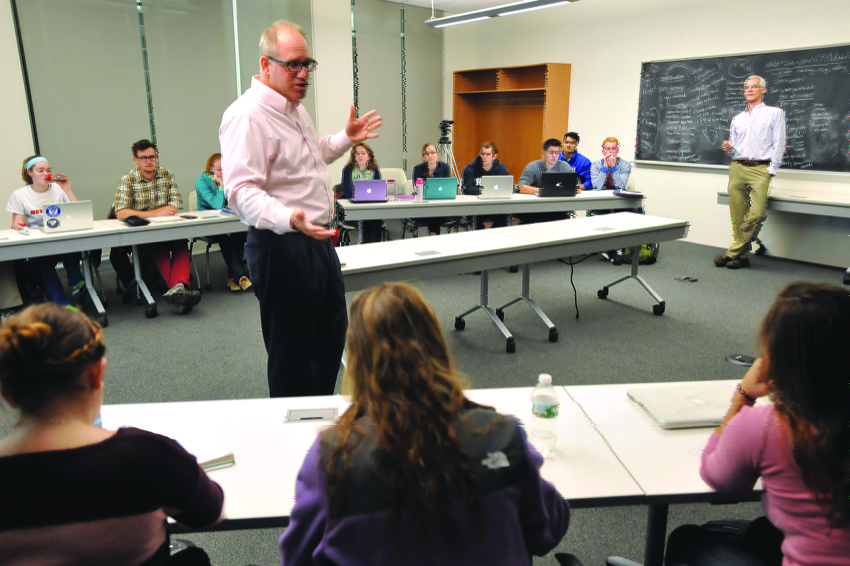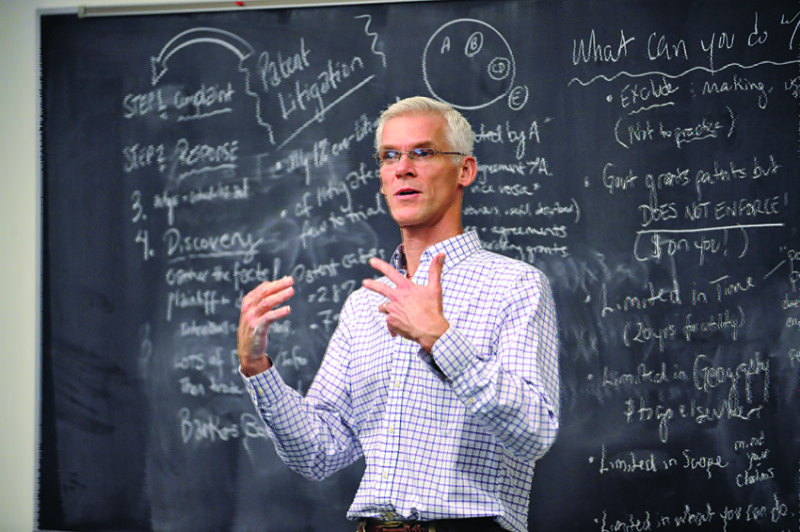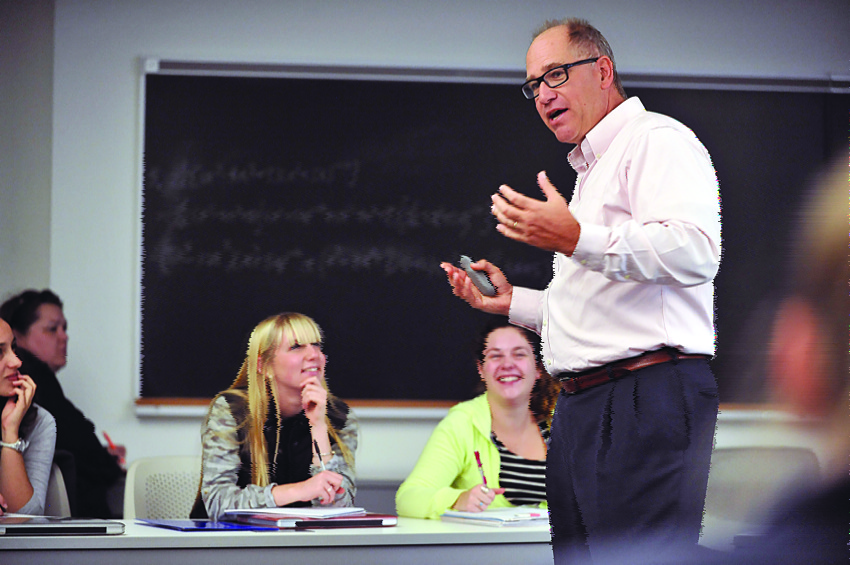The business of science, the science of business

Every pill has a story. Before it got to a medicine cabinet, that pill had to pass the scrutiny of scientists toiling in labs. It had to win confidence in business meetings and prove itself safe to government regulators.
Along the way, that pill could cost $1 billion or more in investment, and go on to generate billions in profit. That path, in more technical terms, is called life science commercialization, and it drives major sectors of the U.S. economy. It affects taxpayers, doctors, politicians, patients and anyone buying or selling a product that was once developed in a bio lab. Yet few undergraduates in the United States actually learn about that process.
Last fall, Professor of Biology Robert Morris and Visiting Assistant Professor of Business and Management David Huizenga combined their experience and wisdom to form “Applied Health Science” (MGMT 298).
The course examined life science commercialization, and the tension between the good and greed that drives it. Students first mastered the fundamental ways that science and business meet—from funding and patents, to government regulations and profits. In turn, they got a glimpse of their different chosen concentrations functioning in a real-world context, whether they were majoring in the humanities, sciences or social sciences. Ultimately, the professors advocated embracing this tension, and applying it to the competing interests, ethical ideals and practical constraints in contemporary problems.
A healthy tension
Class met once a week in the evenings in the Mars Center for Science and Technology. It was dark outside by the time class started, and one fall night a student rushed to finish his noodle dinner on a paper plate before things began.
Morris jotted notes at the white board, while the students sat in a large diamond, laptops open and eyes on the professors. Huizenga came up with a game. He moved to the center of the room and looked quickly from student to student. The first person to blink had to think of a plausible upside to the surge in prescription painkiller use, he told the group, and immediately focused on one particular student.
“I’m just getting my blinks out!” she protested as her classmates laughed.
The topic this night was “cappers,” slang for patients who commit Medicaid and Medicare fraud to supply illegal opiate prescriptions to the streets. Cappers often have legitimate prescriptions for pain pills, but will go from pharmacy to pharmacy to stockpile pills so they can resell them.
Morris and Huizenga asked the students to change their perspectives and come up with several reasons why the motivations of doctors, politicians and drug companies can converge to lead to prescription drug addictions.
One student offered an example. Pain tolerances can differ from person to person, so doctors may err on the side of over-prescribing pain medicine rather than risk sending someone home with too few pain pills, just to have another office visit to address the pain again. In this case, the doctor was motivated by both “good” in giving the patient enough medicine to feel comfortable and “greed” in saving their own time and expense.
However, individual doctors aren’t the major focus of the “good” and “greed” tension in life science commercialization. Later in the class, Morris reminded the students of how important the U.S. Food and Drug Administration is to the process.
“The FDA is responsible for everything that goes into your body except for tobacco and alcohol,” Morris said.
The FDA is a government agency, but a significant amount of FDA funding comes from the fees drug companies pay to have their potential drugs approved rather than from the taxpayers. Pharmaceutical companies may pay $10 million or more, Huizenga pointed out, to have the FDA review a new drug.
Huizenga asked the students to take a step back. “How do you think you would feel—even if you haven’t had one yet—about talking to your boss?” he asked. “You would feel a duty to do what the person paying you wants you to do. You feel a pressure.”
The students got it, immediately. It’s a conflict of interest—money could influence the FDA to go easier on drug companies. But the professors weren’t done yet. They also asked why society might put up with such a conflict of interest. If drug companies don’t pay for safety testing and a thorough review, who will?
“We’ll pay for it!” a student shouted, referring to taxes. Another student pointed out that well-funded, fast-paced testing gets drugs to people who need them faster—the utilitarian ethics principle (also taught in the class) of the greatest good for the greatest number.
“The FDA has a conflict of interest built into its backbone,” said Morris. He beamed with the students’ responses. The professors wanted the students to see how the system balances the interest in profits by pharmaceutical companies with the needs of the FDA, and with the interest of citizens’ well-being and limited resources.
“When you balance all of that conflict out we as a society say, ‘This is OK,’” said Huizenga.
Patents and people
Although there is no mention of business in its name, “Applied Health Science” was actually a business course. Of the 20 students in the class, Morris said two-thirds were science majors while the remaining students majored in business or the humanities. Many students were surprised to learn what the business side of life science commercialization entails.
Shirley Ngai ’15, an anthropology major planning to become a physician’s assistant, said she didn’t realize before taking the course how much legal rights influenced financial opportunities in medicine.
“Without patents, companies would be less likely to continue their research, be less incentivized to continue research and provide drugs,” said Ngai. “That was just surprising.”

Huizenga has worked in the life sciences industry for decades, as a scientist, a patent attorney, and an entrepreneur. In a typical business setting, he might start explaining life science commercialization in terms of money and finance. But at Wheaton, Huizenga and Morris thought explaining the process in terms of tension would work better.
The course began with an introduction to the tension, the process of life science commercialization, and lectures on intellectual property, followed by four weeks of case studies and role-playing.
“The tension exists between the high price for drugs and the high price for innovation—which necessarily means that not everybody gets access to [treatment]—versus the desire to help people for free,” said Huizenga.
And patents are at the root of that tension, Huizenga and Morris argue. “Patents give you a limited monopoly on the innovation that you do,” said Huizenga, “which allows you to exclude others from selling a product that uses your innovation to compete with you. Which means you can charge a higher price for it.”
However, there can be considerable tension between the company’s pursuit of patents, and the professional pursuits of the scientists they employ. To an extent, entrepreneurs require secrecy, and want to control knowledge of their ongoing progress so that they can secure patents.
Morris, however, gave the view from academia: “In academia, it often behooves people to talk freely so you can protect yourself.” Learning about other researchers’ successes and failures can help a scientist find problems to study that are unique, and find approaches that are most likely to work, he pointed out.
Ryan Barrette ’15, a chemistry major with a pre-med focus, said he valued exploring multiple perspectives. “The class has given me a glimpse of down the road who I might be working with and what kind of challenges and experiences I may be expecting.”
He also noted that the course pushed him and his classmates to think deeply about these issues.
“In assignments, you’re writing not so much to prove that you know the material, but you’re gathering your resources to present your opinion,” said Barrette. “We have debates in class where you’re discussing what the best course of action is.”
Practice acting, not reacting
In one class, in light of the Ebola crisis in West Africa, the professors convened a United Nations-style exercise exploring the tensions in responding to and eventually treating Ebola infections. Each student had to prepare data and arguments to speak on behalf of a number of organizations that grappled with the Ebola outbreak.
As class began, the students picked their representative assignments from a red bowl. They could draw a fictional advocacy group of Ebola survivors or a team from the Johns Hopkins Berman Institute of Bioethics. Others would represent health ministries from Sierra Leone or Guinea; still others picked GlaxoSmithKline or Tekmira—both drug companies working on Ebola therapeutics. The U.S. Centers for Disease Control and Prevention and Doctors Without Borders got places at the table too.
If one of the developing Ebola treatments proved safe enough to use, asked Morris, “Do you have ideas on how that medicine might be distributed first?”
The students representing Ebola survivors said their communities should get the drugs first, because their need is the greatest. Yet the students representing the Berman Institute thought it was best to treat doctors first because they are such a rare resource. There are roughly 150 doctors out of a population of 6 million people in Sierra Leone—the ratio of doctors to patients is one hundred times greater in the United States.
A student representing the ministry of health in Guinea argued that since there weren’t enough funds to distribute medication to most Ebola survivors, the available money could be better used for education. She pointed out that while the World Health Organization donated motorcycles to help transport people from remote areas to hospitals, people using the motorcycles weren’t trained to sterilize them properly.
“They were actually helping to transmit this disease,” she said.
Later in the debate, one student representing Ebola survivors made the case that charity could be a path to profit.
“The charity organization WellPoint is covering the cost of manufacturing the first ten thousand doses of the vaccine. So if you’re selling them for a penny, you are already making some revenue,” a student told the pharma representatives. “Whether or not that is a profit is irrelevant, considering the fact that you are going to have rich Western countries buying hundreds of thousands of doses in a couple months.”
Morris and Huizenga confirmed that the United States has been known to stockpile treatments for contagious diseases out of concern for national security.
The professors had interdisciplinary arguments like these—arguments that combine science, business and ethics—in mind when they started the “Applied Health Science” course as an expansion of the “Biopharma” Connection courses.
“This course is—at its core—an embodiment of Connections,” said Morris.
Tradition of perspective
Morris has been at Wheaton from the beginning of the Connections endeavor. Thirteen years ago he was chatting with James Freeman, associate professor of economics, when the two discovered they both taught the same topics from two different disciplinary perspectives. Morris was presenting drug development and vaccines from a biology perspective in “Cells and Genes” (Bio 112). Freeman was covering vaccines and drug development from an economic perspective in “Microeconomics” (Econ 112).
They thought, “Why not make that natural connection explicit and deliberate, to give the students a more comprehensive view?” So Morris and Freeman developed the “Biopharma” Connection linking Bio 112 and Econ 112.
Morris invited Huizenga to be a guest speaker in the “Biopharma” Connection from the beginning of the Connections program, which provides students with the opportunity to explore different areas of academic knowledge and multiple approaches to problems.

Huizenga has known Morris since graduate school, before they parted ways professionally.
Both men noticed a lot of interest from students during Huizenga’s guest lectures. Some students would show up for lectures even if they weren’t earning credit. Since there was more material in the life science commercialization process than Huizenga and Morris could cover through guest lectures, they decided to write a book, From Good to Greed: The Tension in Life Science Commercialization.
Nicole Jenkins ’15 decided to audit “Applied Health Science” after taking the “Biopharma” Connection. “I’m mainly here out of the joy of learning,” said Jenkins, a biochemistry major who hopes to become a pediatrician.
“I’m now aware of a lot of the things that go on behind the scenes, and a lot of things that would affect me as a physician,” said Jenkins. “Yes, I would hopefully be treating people and making them feel better—but there is also a business aspect of the job that I wouldn’t necessarily have gotten if I hadn’t taken this class.
“It really is a bridge between management, businesses and biology,” she said. “And now I can talk about a patent or copyright, which I wouldn’t have known anything about.”
Morris also thought the concept for “Applied Health Science” would fit nicely in Wheaton’s relatively new business and management major. “Wheaton does it really well. It’s an unusual, applied and socially conscious business program,” he said.
Just as the Wheaton business program asks students to learn business in the context of social, health and humanitarian issues, the professors knew the life science commercialization process faced inherent social, health and humanitarian dilemmas.
Lessons to take out into the world
Kaitlyn Solano ’16 realized some of the ethical dilemmas covered in “Applied Health Science” were already appearing in her other science courses.
“I did research for a different chemistry course, and in the research it talked about HeLa cells,” said Solano, who is a biochemistry and Latin double major. “That’s something you just glance over and think, ‘Oh whatever. It’s just another tool we can use.’ But by taking this class, I learned a different history behind HeLa cells and the controversy.”
HeLa cells are named for Henrietta Lacks, a woman who died of cervical cancer in 1951. Doctors took her cells for research without permission, and without notifying her family. Her cell line lived on and is used by researchers worldwide today. Students in “Applied Health Science” read about her story in The Immortal Life of Henrietta Lacks by Rebecca Skloot (February 2010, Crown Publishers) as an assignment.
Solano, who wants to be a pediatrician one day, says “Applied Health Science” gave her a new view of her future career.
In other courses, “You learn about the skills of being a doctor, and the passion behind being a doctor, but you don’t really learn about what it really means once you get in there—to be in the business,” said Solano.
Morris and Huizenga designed the class to be a deliberately interdisciplinary exploration. But other students found serendipitous connections to their other courses.
Barrette worked on an honors thesis with Associate Professor of Chemistry Laura Muller, investigating the process of preparing lead oil used in lead paints for art restoration.
Some of the molecules discussed in the business management class were actually similar to ones he studied in an organic chemistry class.
“We know all this theoretical background, how we work with them in the lab, but it’s good to know what’s going on in the real world,” said Barrette. “It was really interesting to see that same science here—what this molecule really does, how it was found, and how they [the entrepreneurs] want to use it in the real world and go apply it.”
Barrette’s mother is a Wheaton alum who works in the regulatory side of the pharmaceutical industry. Even with this background, he realized there were aspects to life science commercialization he hadn’t even encountered.
“It was interesting to hear about the investing process and the start-ups, and where they get those funds initially,” he said. “I knew that there was a lot of money involved in the industry, but where the initial funding came from was more surprising.”
Morris and Huizenga hope the students will take the interdisciplinary exposure of “Applied Health Science” into their careers, as well as the understanding that the fruitful tension between working for the good of society and working for profit is mutually reinforcing and is what incentivizes innovation.
“Ambiguity is discomforting, but it’s necessary,” said Morris. “And grappling with that uncertainty is a valuable experience as an undergraduate. We try to create that opportunity in our classroom for students to confront those issues and consider the idea that good and greed are both necessary.”
Photos and photo illustration by Keith Nordstrom
